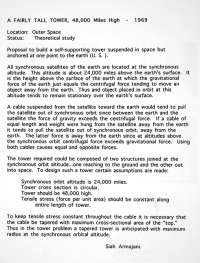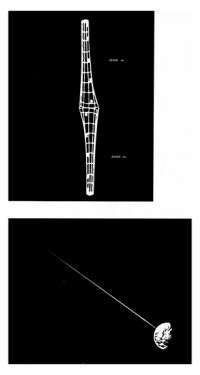Location: Outer Space
Status: Theoretical study
Proposal to build a self-supporting tower suspended in space but anchored at one point to the earth (U. S. ).
All synchronous satellites of the earth are located at the synchronous altitude. This altitude is about 24,000 miles above the earth's surface. It is the height above the surface of the earth at which the gravitational force of the earth just equals the centrifugal force tending to move an object away from the earth. Thus and object placed in orbit at this altitude tends to remain stationary over the earth's surface.
A cable suspended from the satellite toward the earth would tend to pull the satellite out of synchronous orbit since between the earth and the satellite the force of gravity exceeds the centrifugal force. If a cable of equal length and weight were hung from the satellite away from the earth it tends to pull the satellite out of synchronous orbit, away from the earth. The latter force is away from the earth since at altitudes above the synchronous orbit centrifugal force exceeds gravitational force. Using both cables causes equal and opposite forces.
The tower required could be composed of two structures joined at the synchronous orbit altitude...one reaching to the ground and the other out into space. To design such a tower certain assumptions are made:
Synchronous orbit altitude is 24,000 miles.
Tower cross section is circular.
Tower should be 48,000 high.
Tensile stress (force per unit area) should be constant along entire length of tower.
To keep tensile stress constant throughout the cable it is necessary that the cable be tapered with maximum cross-sectional area of the "top." Thus in the tower problem a tapered tower is anticipated with maximum radius at the synchronous orbital altitude.
Siah Armajani.
Location: Outer Space
Status: Theoretical study
Proposal to build a self-supporting tower suspended in space but anchored at one point to the earth (U. S. ).
All synchronous satellites of the earth are located at the synchronous altitude. This altitude is about 24,000 miles above the earth's surface. It is the height above the surface of the earth at which the gravitational force of the earth just equals the centrifugal force tending to move an object away from the earth. Thus and object placed in orbit at this altitude tends to remain stationary over the earth's surface.
A cable suspended from the satellite toward the earth would tend to pull the satellite out of synchronous orbit since between the earth and the satellite the force of gravity exceeds the centrifugal force. If a cable of equal length and weight were hung from the satellite away from the earth it tends to pull the satellite out of synchronous orbit, away from the earth. The latter force is away from the earth since at altitudes above the synchronous orbit centrifugal force exceeds gravitational force. Using both cables causes equal and opposite forces.
The tower required could be composed of two structures joined at the synchronous orbit altitude...one reaching to the ground and the other out into space. To design such a tower certain assumptions are made:
Synchronous orbit altitude is 24,000 miles.
Tower cross section is circular.
Tower should be 48,000 high.
Tensile stress (force per unit area) should be constant along entire length of tower.
To keep tensile stress constant throughout the cable it is necessary that the cable be tapered with maximum cross-sectional area of the "top." Thus in the tower problem a tapered tower is anticipated with maximum radius at the synchronous orbital altitude.
Siah Armajani.

